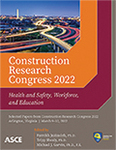Role of Safety Training in Reducing Fatigue among Construction Workers
Publication: Construction Research Congress 2022
ABSTRACT
Construction is one of the most hazardous industries for its workers responsible for performing physically and mentally demanding tasks. Several factors impact the safety performance of construction workers. The inherent nature of construction makes workers susceptible to suffer from high-fatigue levels. Fatigue has been proven to have adverse impacts on the functionality of workers and their safety performance. In other words, reducing fatigue positively contributes to safety risk mitigation and accident prevention in construction. Safety training programs (i.e., OSHA 10/30) aim to enhance construction safety and prevent accidents. Therefore, this study hypothesized that such safety training programs equip construction workers with the necessary skills to reduce fatigue risk. To test the research hypothesis, 117 construction workers in the United States participated in the study. Fifty-six (48%) workers had received OSHA 10 and/or 30-hour training, while 60 (52%) of them had not received the training. The fatigue levels of both groups were measured using Occupational Fatigue Exhaustion Recovery (OFER) Scale. The data analysis showed a significant difference (p-value < 0.01) in the fatigue levels between workers who received OSHA safety training (OFER-Score = 33%) and workers who did not receive safety training (OFER-Score = 42%). The results of this study demonstrate that safety training such as OSHA 10/30 is associated with lower fatigue levels among workers. The findings suggest that such training courses that familiarize workers with safety skills (e.g., mitigating ergonomic risks) can help them perform their duties effectively and ergonomically, leading to lower fatigue levels.
Get full access to this article
View all available purchase options and get full access to this chapter.
REFERENCES
Al-Bayati, A. J., Albert, A., and Ford, G. (2019). “Construction Safety Culture and Climate: Satisfying Necessity for an Industry Framework.” Practice Periodical on Structural Design and Construction, American Society of Civil Engineers, 24(4), 04019028.
Aryal, A., Ghahramani, A., and Becerik-Gerber, B. (2017). “Monitoring fatigue in construction workers using physiological measurements.” Automation in Construction, 82, 154–165.
Fang, D., Jiang, Z., Zhang, M., and Wang, H. (2015). “An experimental method to study the effect of fatigue on construction workers’ safety performance.” Safety Science, 73, 80–91.
Halvani, G. H., Zare, M., and Hobobati, H. (2009). “The fatigue in workers of Iran Central Iron Ore Company in Yazd.” International Journal of Occupational Medicine and Environmental Health, 22(1), 19–26.
“Intellectus Statistics.” (n.d.). <https://analyze.intellectusstatistics.com/#>(Jun. 24, 2020).
Javadpour, F., Keshavarzi, S., Choobineh, A. R., and Aghabeigi, M. (2014). “Validity and reliability Of Occupational Fatigue/Exhaustion Recovery scale (OFER-15) among Iranian working population.” Iran Occupational Health, Iran Occupational Health, 11(6), 75–83.
Michielsen, H. J., De Vries, J., Van Heck, G. L., Van de Vijver, F. J. R., and Sijtsma, K. (2004). “Examination of the Dimensionality of Fatigue: The Construction of the Fatigue Assessment Scale (FAS).” European Journal of Psychological Assessment, Hogrefe & Huber Publishers, Germany, 20(1), 39–48.
Min, A., Min, H., and Hong, H. C. (2019). “Psychometric properties of the Korean version of the Occupational Fatigue Exhaustion Recovery Scale in a nurse population.” Research in Nursing & Health, 42(5), 358–368.
Namian, M., Albert, A., Zuluaga, C. M., and Behm, M. (2016a). “Role of Safety Training: Impact on Hazard Recognition and Safety Risk Perception.” Journal of Construction Engineering and Management, American Society of Civil Engineers, 142(12), 04016073.
Namian, M., Albert, A., Zuluaga, C. M., and Jaselskis, E. J. (2016b). “Improving Hazard-Recognition Performance and Safety Training Outcomes: Integrating Strategies for Training Transfer.” Journal of Construction Engineering and Management, 142(10), 04016048.
Namian, M., Kermanshachi, S., Khalid, M., and Al-Bayati, A. J. (2020). “Construction Safety Training: Exploring Different Perspectives of Construction Managers and Workers.” Conference: 2020 ASEE Annual Conference & Exposition.
Namian, M., Taherpour, F., Ghiasvand, E., and Turkan, Y. (2021). “Insidious Safety Threat of Fatigue: Investigating Construction Workers’ Risk of Accident Due to Fatigue.” Journal of Construction Engineering and Management, American Society of Civil Engineers, 147(12), 04021162.
Namian, M., Zuluaga, C. M., and Albert, A. (2016c). “Critical Factors That Impact Construction Workers’ Hazard Recognition Performance.” Construction Research Congress 2016, American Society of Civil Engineers, San Juan, Puerto Rico, 2762–2772.
“OSHA Outreach Training Program - Construction Industry | Occupational Safety and Health Administration.” (2019). <https://www.osha.gov/dte/outreach/construction/>(Jun. 8, 2021).
Phillips, R. O. (2014). What is fatigue and how does it affect the safety performance of human transport operators? 6.
Taherpour, F., Kashmiri, D., Namian, M., and Ghiasvand, E. (2020). Safety Performance of a Fatigued Construction Worker. American Society of Civil Engineers, 591–598.
US Bureau of Labor Statistics. (2019). “Census of Fatal Occupational Injuries (CFOI) - Current and Revised Data.” <https://www.bls.gov/iif/oshcfoi1.htm>(Jun. 9, 2020).
de Vries, J., Michielsen, H., Heck, G. L. V., and Drent, M. (2004). “Measuring fatigue in sarcoidosis: The Fatigue Assessment Scale (FAS).” British Journal of Health Psychology, 9(3), 279–291.
Winwood, P. C. (2005). “Manual for the Occupational Fatigue, Exhaustion Recovery scale, (OFER).”
Winwood, P. C., Winefield, A. H., Dawson, D., and Lushington, K. (2005). “Development and Validation of a Scale to Measure Work-Related Fatigue and Recovery: The Occupational Fatigue Exhaustion/Recovery Scale (OFER).” Journal of Occupational and Environmental Medicine, 47(6), 594–606.
Zhang, M., Sparer, E. H., Murphy, L. A., Dennerlein, J. T., Fang, D., Katz, J. N., and Caban‐Martinez, A. J. (2015). “Development and validation of a fatigue assessment scale for U.S. construction workers.” American Journal of Industrial Medicine, 58(2), 220–228.
Zuluaga, C. M., Namian, M., and Albert, A. (2016). Impact of Training Methods on Hazard Recognition and Risk Perception in Construction. American Society of Civil Engineers, 2861–2871.
Information & Authors
Information
Published In
History
Published online: Mar 7, 2022
Authors
Metrics & Citations
Metrics
Citations
Download citation
If you have the appropriate software installed, you can download article citation data to the citation manager of your choice. Simply select your manager software from the list below and click Download.
